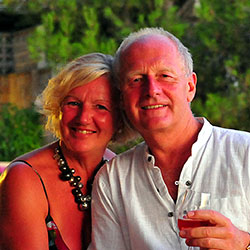A pictorial, three part, worldwide appreciation of outdoor visual treats.
In this three part overview we give a very limited and brief insight into the wonderful art forms that can be found right in front of you in virtually every country of the world – bringing an intimate view of social and cultural trends, opinion, unrest and passions that would otherwise be missed when viewing the more conventional hot-spots in the countries you visit.
Part 1. Graffiti
Graffiti has long been the preserve of marauding delinquents set on leaving their resentful anti-social mark on the property of those for whom they have little regard.
Nowadays, much as reactionary Punk Rock subsequently melded seamlessly into the middle-of-the-road music scene and became universally accepted, so Graffiti has become an art form in its own right with some Tags (signatures), such as ‘Banksy’ elevated into the realms of valuable street art.

Discordant but distinctive graffiti on a street wall in Quito, Ecuador
Much graffiti remains simply a wanton defacing of otherwise pristine walls and buildings and imparts little to the traveller’s experience – other than degrading the surroundings and offering a warning as to the nature of the neighbourhood, to deter further investigation. But not all.

An otherwise desolate street scene of closed shops enlivened by the addition of accomplished art in Rouen, France
Much of it, however, brings a different dimension to the enjoyment of the street in many countries and can offer an insight into social trends, concerns and comment.
On our travels we’ve often been aware of graffiti around us and photographed the more distinctive as a reflection and very much part of the fabric, of the places we’ve been.

East Side ‘Art’ Gallery of social and political comment on the remains of one sector of the Berlin Wall
In Berlin, for example, the remains of the Berlin wall in one sector have become the ‘East Side Gallery, which in effect is a stretch of wall dedicated to the visual representation of struggles that beset the East-West Cold War period of the fifties and sixties – but whose messages prevail today.
These images are regularly refreshed and renewed as a lasting social and political comment.

Kliptown in Soweto, Johannesburg, proclaims it s own identity in colour
In the Soweto townships of Johannesburg however, graffiti appears to be more a striving for identity and recognition rather than simple social comment. This was never more evident than in the covering in graffiti of one of the massive cooling towers of an industrial plant that was spreading toxic pollution over the townships – acting as a beacon of despair that eventually resulted in the closing of the plant.

An otherwise derelict and rundown building is ‘lifted’ by the addition of colour to the street. Havana, Cuba
Much of this work, we believe actually improves otherwise run-down, derelict or neglected areas, such as in the backstreets of Havana, Cuba – with the exception, as always, of the hastily scrawled tag with no accompanying artwork!
Graffiti now crosses the boundary between disapproval and approbation – and our only differentiation between graffiti and street art must really be that of ‘permission’ – where graffiti is that art applied without the property owner’s permission.
Otherwise there seems little to choose between the work that now adorns vast areas of available free surfaces globally. It’s often difficult to decide which is which and to wonder how a sustained period of painting might have gone unnoticed!

Probably a fait accompli by the time the owners looked at the rear of their building.
- No surface
- is sacred
- for colour
- or community
Take a look at the breadth of design and content in these images and see them not as the delinquent scrawling of pond life but the more considered expression of people with something to say who have found a vehicle for their voice.

Hiding in plain sight, or simply a bona fide street artist?
We wonder if there is a geographical pattern to the application of graffiti. It seems as though it is less evident in autocratic countries, where presumably penalties are much harsher for the desecration of property – and we’ve seen very little in India, where one might assume, there’s very little free space available to paint on! This would also render it virtually invisible – such is the nature of profuse colour and visual clutter in India.
India seems so colourful and confused that street art would be lost and those most inclined to do so probably can’t afford to.

I’m sure I can paint something somewhere!
Similarly, the further east we have travelled, the less graffiti we have seen – perhaps because of an inherent cultural respect for property, as we can’t imagine that artistic talent (if that’s what we can agree it is) is lacking in any way.
If you have any theories of your own, then please share them with us as this art form is on the increase – not only in quantity but in quality of expression and artistic ability.
Judge for yourself as you browse through these images and do please let us know.

These cave ‘paintings’ in Churna, Satpura National Park, India are reputed to be over 10,000yrs old
Graffiti is perhaps the earliest form of self-expression and social comment that has endured since man walked the earth. Witness the earliest of cave paintings, which presumably no one asked permission to do!

The Viñales Mural de la Prehistoria is the work of the former Director of Mapping at the Cuban Academy of Sciences, Leovigildo González Morillo.
The even more recent cliff face painting on a grand scale in Cuba by Leovigildo González Morillo, a master of neo-caveman artistry, decide to portray world history up until the age of humans on a rock wall in the Viñales Valley – suggesting that graffiti is alive and well.
One thing’s for sure – however temporary the medium, graffiti is here to stay!

We’ve seen images like this on our travels all around the world. Let us paint you some pictures about your future travel and devise something equally as colourful for you.

 Let us plan your own inspiring journey to the more colourful places in the world
Let us plan your own inspiring journey to the more colourful places in the world
Why not download the TLC World guide brochure or give us a call today on 01202 030443, or simply click ‘enquire’ to submit your own personal itinerary request






























